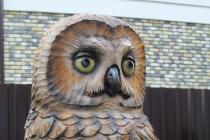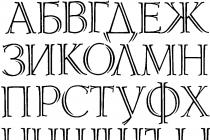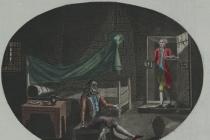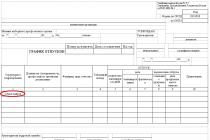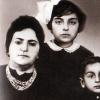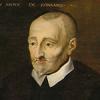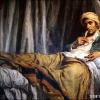People who took such a difficult path seemed crazy, ignored all the benefits, and meekly destroyed a hail of endless barbs, disrespectful treatment, and various punishments.
Allegorically speaking, they tried to find their way to human hearts and souls, spreading ideas kindness and compassion, deception and bias were condemned.
Not all people managed to pacify the seeds of pride, ignore bodily needs, or become nobler in spirit than others. One of these is Blessed Basil - a glorious and revered holy fool.
Birth and youth
The course of his existence is amazing (from the very beginning). December 1469(according to other sources – 1464). Steps onto the church porch Serf Anna(Epiphany Cathedral in the village of Elohovo). She came to pray for an easy birth.
The sounds of her prayer were heard by the Virgin Mary. There, Anna gave birth to a boy, they named him Vasily (named Vasily Naga). A crystal soul and an open heart are what he came into the world with.
His father and mother were serfs. They were pious, revered Christ, based their existence according to his commandments. From an early age, they instilled in their son a courteous and reverent attitude towards God. Vasily grew up, and, wishing a good and better son, his father and mother decided to take him to shoe business.
Working as an apprentice
The young student stood out for his diligence and humility. His master would never have understood what an unusual person Vasily was if not for one unexpected incident.
A merchant stepped onto the threshold. A man approached a shoemaker with a request to sell him good boots that would last for many years. Vasily, shedding tears, said that a person does not need boots, since he will die tomorrow and it happened exactly as Vasily said.
Road to Moscow
Because of this incident, Vasily decided to say goodbye to the shoe business and put his life on the thorny road of stupidity. Until his death he lived at no cost, uninsured from mockery and insults, having only an invisible guardian - faith and unshakable love for the Lord.
He left his parents and went to the capital. At first, people reacted with amazement and caustics to the wonderful naked guy. But soon the townspeople recognized him as a man of God, a fool for Christ's sake.
What was he like
Saint Basil (also known as Basil the Blessed, Basil the Fool, Wonderworker of Moscow or Blessed Basil of Moscow, Fool for Christ) – Russian Orthodox saint, known as the "fool" or "holy fool" of Jesus Christ. He was officially canonized approximately in 1580.
St. Basil's Cathedral in Moscow is named after the saint. Originally a shoemaker's apprentice in Moscow, he accepted eccentric lifestyle, but helped those in need. It is believed that he had the gift of clairvoyance.
He lived on Red Square itself when this place served as the main market of Moscow. One day Saint Basil threw out the baker's bread, and the man had to admit that he was adding lime to the flour. In 1547, Saint Basil came to the central cathedral in Moscow and began to pray tearfully.
The next day the Great Moscow Fire occurred, and it started in the church exactly where the saint prayed.
They also talk about other miracles of St. Basil. Once a merchant consulted with him: the church vaults he was erecting, for three unknown reasons, collapsed. The holy fool advised him to find a poor man (Ivan in Kyiv).
Following the recommendation, the merchant found the lad in a poor house (he was finishing an empty cradle). The merchant asked what this meant. The poor man explained that this was how he decided to show respect to his mother. The unfortunate “architect” understood why the Wonderworker sent him here.
In fact, even earlier he kicked his mother out of the house. Not regretting what he did, he wanted to praise the Almighty for the built temple. The creator refused to accept the gift from the man who was not a good soul. Blessed Vasily helped this man: he repented, reconciled with his mother, and she forgave him.
Holy Elder remained naked and dragged heavy chains behind him. He reproached Ivan the Terrible for not paying attention to the church, and especially for his cruel attitude towards the innocent.
Presented himself to the Lord
When St. Basil died ( August 2, 1552 or 1557), Metropolitan Macarius of Moscow served at his funeral with many representatives of the clergy. Ivan the Terrible himself behaved like a friend of the Wonderworker and carried his coffin to the cemetery.
The elder is buried in St. Basil's Cathedral (in Moscow), which was ordered for construction by Ivan IV (in memory of the capture of the Kazan Khanate). The cathedral is also famous as the “Cathedral of the Intercession of the Most Holy Theotokos on the Moat.” In 1588, Fyodor Ivanovich added a chapel over the grave of St. Basil on the eastern side.
St. Basil the Blessed(1469, the village of Elokhovo near Moscow - August 2, 1552, Moscow) - Russian saint, holy fool: sometimes he is called “Vasily Nagoy”.
St. Basil the Blessed is the Moscow holy fool. He was born in December 1469 in the village of Elokhovo (now within the city limits of Moscow), on the porch where his mother came to pray for a “safe resolution.”
His parents, peasants, sent him to study shoemaking. A hardworking and God-fearing young man, the life tells, Vasily was awarded the gift of insight, which was discovered by chance. After sixteen years and until his death, he performed the feat of foolishness, without shelter and clothing, exposing himself to great hardships. The life of the Blessed One describes how he taught the people moral life both by word and example. He went without clothes all year round, slept in the open air, constantly fasted, and endured hardships.
He constantly exposed lies and hypocrisy. Contemporaries noted that this was almost the only person whom Tsar Ivan the Terrible was afraid of. Tsar Ivan Vasilyevich the Terrible honored and feared the Blessed One, “as a seer of human hearts and thoughts.” When, shortly before his death, Vasily fell into a serious illness, the Tsar himself visited him with Tsarina Anastasia.
Saint Basil died on August 2, 1552 (sometimes the year 1551 is also mentioned). Ivan the Terrible and the boyars carried his coffin, and Metropolitan Macarius performed the burial.
Vasily's body was buried in the cemetery of the Trinity Church in the Moat. Since 1588, they began to talk about miracles occurring at the tomb of Blessed Basil; As a result, Patriarch Job determined to celebrate the memory of the miracle worker on the day of his death, August 2.
Miracles
Many miracles are attributed to St. Basil, both during his life and after his death.
- A man came to Vasily’s owner to order boots and asked to make ones that he would not wear until his death. Vasily laughed and cried. After the merchant left, the boy explained his behavior to the master by saying that the merchant was ordering boots that he could not wear, since he would soon die, which came true.
- One day, thieves, noticing that the saint was wearing a good fur coat, given to him by a certain boyar, decided to deceive it from him; one of them pretended to be dead, and the others asked Vasily for burial. Vasily seemed to cover the dead man with his fur coat, but seeing the deception, he said: “Fox fur coat, cunning, cover up the fox’s deed, cunning. May you be dead from now on for wickedness, for it is written: Let the wicked be consumed.” When the dashing people took off his fur coat, they saw that their friend was already dead.
- One day, Blessed Vasily scattered rolls of bread from a baker at the market, and he admitted that he had mixed chalk and lime into the flour.
- The Degree Book tells that in the summer of 1547 Vasily came to the Ascension Monastery on Ostrog (now Vozdvizhenka) and prayed for a long time in front of the church with tears. The next day, the famous Moscow fire began, precisely from the Vozdvizhensky Monastery.
- While in Moscow, the saint saw a fire in Novgorod, which he put out with three glasses of wine.
- With a stone he smashed the image of the Mother of God on the Varvarinsky Gate, which had long been considered miraculous. A crowd of pilgrims, flocking from all over Rus' for the purpose of healing, attacked him and began to beat him to death. The holy fool said: “And you will scratch the paint layer!” Having removed the paint layer, people saw that under the image of the Mother of God there was a “devilish mug”.
St. Basil's Cathedral
The Moscow Cathedral of the Intercession of the Blessed Virgin Mary, on the Moat, began to be built in 1555 by order of Tsar Ivan the Terrible in memory of the capture of Kazan. After the canonization of the saint, by order of Tsar Fyodor Ioannovich in 1588, a church in honor of St. Basil was added to the Intercession Church - above the burial of Vasily, as a stylized inscription on the wall of this church tells. Today the entire cathedral is better known as St. Basil's Cathedral.
The memory of St. Basil in Moscow was celebrated with great solemnity: the patriarch himself served and the tsar himself was usually present at the service.
Blessed Basil - quotes
The great unrest will continue in the kingdom for a long time until it is stopped by a great warrior called by all our people... ![]()
Moscow miracle worker, holy fool for Christ's sake. He had the gift of foresight. Also known as Vasily "Naked". Lived during the reign of Ivan IV the Terrible. Canonized by the Russian Orthodox Church in 1588. Memorial Day August 2(15).
Since the baptism of Rus', the Orthodox faith and traditions have always been alive and deeply revered. They went into battle for their faith, suffered hardships, and died. The feat of foolishness was especially revered. People who embarked on this difficult path deliberately pretended to be insane, renounced all worldly goods, and humbly endured endless ridicule, contempt, and all sorts of punishments. And in an allegorical form they tried to reach the hearts and souls of people, preaching goodness, mercy and exposing untruth and injustice. Few could pacify pride, moderate bodily needs, and rise spiritually above the rest. Over the entire history of Orthodoxy in Rus', more than 130 people have accomplished such a spiritual feat, 36 of them have been canonized.
One of the most famous and revered by Christ for the sake of holy fools was Basil the Blessed, also called Basil “Naked.” His fate has been amazing since birth. In December 1469, his mother Anna came to the porch of the Epiphany Cathedral near Moscow in Elohovo (now the territory of Moscow) to pray that her child would be born safely and healthy. The Mother of God heard the prayers of a simple woman, and right there, right on the porch, Anna gave birth to a boy, who was named Vasily. He came into this world with a pure soul and an open heart.
His parents were simple peasants, they were very pious, they revered Christ, lived according to his commandments, and from early childhood they instilled in Vasily respect and reverence for the Almighty. When the boy grew up, his parents, wanting a good life for their son, sent him to be apprenticed to a shoemaker. Time passed, Vasily learned the basics of the craft, the shoemaker was pleased with the hardworking and obedient guy. Vasily would have worked like this all his life, if not for one incident, during which the diligent and pious 16-year-old apprentice discovered the gift of insight.
A merchant approached the workshop, wanting to sew boots that would be worn for many years. The distressed Vasily promised to fulfill the order, but after the merchant left he burst into tears, which greatly surprised the shoemaker. In response to the owner’s bewildered question, the guy explained that the merchant was not destined to show off in a new thing, since he would soon die. The shoemaker was surprised, but did not attach any importance to the guy’s strange words. A few days later, that merchant actually died, and Vasily decided to leave the shoemaker's craft and devote his life to the greatest feat in the name of Christ - foolishness. From that moment until his death, he walked naked and barefoot, having no savings, no protection from scoffers and offenders, except for the invisible amulet - faith and all-encompassing love for the Lord. The only clothes he wore were chains - iron rings and chains for bodily humility and strengthening of the spirit.
After the incident at the shoemaker's, Vasily left his parents and headed to. At first, the people marveled at the strange naked guy and mocked him, but soon the Muscovites recognized him as a man of God, Christ for the sake of the holy fool, an exposer of injustice and untruth.
The incomprehensible and strange at first glance actions of St. Basil angered people, but then it always turned out that there was a hidden instructive meaning in these actions. Once, having deliberately scattered rolls from a merchant at the market, he humbly accepted the abuse and beatings. But later the kalachnik admitted that he added lime and chalk to the dough. Another time, his advice helped a merchant complete a church whose vaults had already collapsed three times. The merchant asked the blessed one for advice on how to complete the temple. Vasily sent him to Kyiv to the poor man Ivan. Finding a man rocking an empty cradle in a poor home, the merchant asked why he was doing this. He said that this is how he pays tribute to the mother who gave birth to him. The merchant understood why Vasily sent him to Kyiv. It turned out that at one time he kicked his own mother out of the house, and without repentance for his action, he wanted to glorify God with the church he built. But the Almighty did not accept a gift from a low-hearted person. St. Basil the Blessed helped the merchant to repent, make peace with his mother and beg her forgiveness. After this, God's temple was successfully completed.
St. Basil the Blessed showed many miracles to Muscovites. Passing by the houses of devout people, he threw stones into their corners, and near the houses where they were committing outrages, he kissed the corners. To questions about such strange behavior, the holy fool replied that in the houses where the righteous live there is no place for demons, and they stand on the street near the corners, and he drives them away. And in houses where vices have settled, demons dance and do not allow angels to enter there, grieving for the souls of people outside the house. And thus Basil invites the angels to enter.
Another time, St. Basil walked through a bazaar where women were sitting selling their handicrafts. The holy fool's nakedness did not bother them - they simply laughed. And then they went blind. One of the women, who had not yet gone completely blind, realized what had happened, rushed after the holy fool and tearfully asked for her and her friends’ sight to be restored. St. Basil agreed on the condition that they repent of their stupidity. The women obeyed him, repented and became sighted again.
Constantly abstaining from earthly pleasures, uncomplainingly enduring the hardships of foolishness, living on the streets among crowds of people, enduring severe hardships, St. Basil kept his soul pure and bright. The gift of insight manifested itself more and more in him.
The Almighty helped Blessed Basil to predict the invasion of Moscow by Khan Mehmed I Giray in 1521. That time, as usual, praying at night at the gates of the Church of the Mother of God, he saw a sign - fire escaping from the windows of the temple, and began to pray zealously. The fire began to fade little by little and soon disappeared completely. Some time after this vision, the Crimean Tatars attacked the Nikolo-Ugreshsky monastery and the villages closest to it, plundered and burned them, but never reached Moscow.
On July 8, 1543, St. Basil again had a vision in the church, predicting a terrible fire, during which the Holy Cross Monastery, the Tsar's and Metropolitan's courtyards, and several streets were completely burned out: Bolshoy Posad, Neglinnaya and the entire Great Torg.
One winter, one boyar, sympathizing with the holy fool, persuaded him to take a fur coat as a gift. St. Basil did not agree for a long time, but in order not to offend the good man, he accepted this gift. Walking down the street in a donated fur coat, Vasily met a gang of thieves who, not risking taking the rich clothes from the revered holy fool by force, performed a whole performance in front of him. One of them pretended to be dead, and the rest began to ask for a fur coat to cover their dead comrade. The holy fool himself covered the thief with a fur coat, asking if he really died. The thieves confirmed the death of their friend, and Vasily wished that hypocrisy be punished and left. Rushing towards the “dead”, the thieves were dumbfounded - he was truly dead.
The whole life of St. Basil was aimed at helping people, mercy and sympathy. He helped everyone, but especially those who were ashamed to ask for help. One day he gave all the royal gifts to a foreign merchant who had lost his money and had been starving for several days. The merchant himself could not ask for help, because he was wearing rich clothes. St. Basil often visited China Town. There was a correctional prison for drunkards there. The holy fool went to them to help them return to normal life with encouraging words and exhortations.
The king revered the holy fool, but was also afraid of him. He saw him as a man of God who constantly reminded him of the need to live justly and do good deeds. Several cases convinced Ivan the Terrible that before him was truly a pious holy fool, detached from worldly concerns. Having once invited St. Basil to his palace for a feast, the Tsar was very angry when he threw wine out the window three times in a row. The king did not believe the holy fool’s explanation that this was how he put out the fire in the city, until a messenger arrived from there with the news of the fire and the miraculous intervention of some naked man who poured the fire from a waterpot. Afterwards, the Novgorodians who came to Moscow recognized St. Basil as that same person.
When the tsar decided to build a palace on the Sparrow Hills, all his thoughts revolved around this construction. Even when he came to church on a holiday, he thought about the unfinished construction. St. Basil the Blessed was at the festive service, but the Tsar, immersed in his thoughts, did not notice him. After the service, Ivan the Terrible began to reprimand the holy fool for allegedly not being in church. Vasily shamed the autocrat by saying that the tsar’s body was in the church, but his soul was hovering around his unfinished palace. Since then, Ivan the Terrible began to respect and fear the holy fool even more. And when St. Basil became seriously ill, Tsar Ivan and the queen visited him.
Despite a life full of hardships, St. Basil lived for almost 90 years, and when he fell ill and could no longer get up, the tsar himself and his family visited him, and for Christ’s sake the holy fool predicted to the tsar’s son that he would rule in Rus'.
Basil the Blessed died on August 2, 1557 at the age of 88. Tsar Ivan the Terrible and his boyars carried his coffin, and the funeral service and burial were conducted by Metropolitan Macarius of Moscow and All Rus'. During the burial of St. Basil the Blessed, many sick people recovered. The holy fool was buried in the cemetery of the Trinity Church in the Moat, where shortly before, in 1554, the tsar ordered to be erected in memory of the conquest. A chapel was built in the cathedral in honor of St. Basil the Blessed. The veneration of St. Basil's was so strong that from then on the Trinity Church began to be called by one common name - St. Basil's Cathedral.
Miracles did not end with the death of St. Basil. They also took place near his coffin. Therefore, in 1588, during the reign of Fyodor Ivanovich, the son of Ivan the Terrible, the Moscow Patriarch at the Local Church Council canonized the saint and established a day of remembrance for the miracle worker on the day of his death - August 2.
Other miracles of St. Basil's
One day, a holy fool broke the image of the Mother of God on the gates of the temple with a stone, which for many years was considered miraculous. A crowd of pilgrims attacked him with fists and beat him severely. Having resignedly endured the beatings, St. Basil advised to scrape off the layer of paint on the image and when they did this, they saw that under the face of the Mother of God there was an image of the devil.
A Persian ship with many people was sailing along the Caspian Sea. There were also Orthodox Christians among them. A strong storm began, the ship began to rock violently, water poured onto the deck, it became so dark that the helmsman could not see where to direct the ship. Death seemed inevitable. But the Christians told the Persians that they have a miracle worker in Moscow who walks on water as if on earth and pacifies the largest waves. At this time, a naked bearded old man appeared in front of the ship and led the ship on the right course straight through the storm. The waves died down, the old man also disappeared, but everyone was saved. After some time, the Persian merchants who were on that ship came to Moscow on trade business and recognized the holy fool Basil as the naked old man who saved them from imminent death. More than once, a prayer to St. Basil saved ships from certain death in a raging sea.
On August 2, 1588, in the presence of Tsar Fyodor Ivanovich, Metropolitan Job of Moscow and All Rus' and numerous Moscow residents, his image appeared over the burial place of the saint. After this event, a reliquary decorated with precious stones was placed over the burial place, and after praying near it, many sick people were completely healed.
Saint's Memorial Day August 2 (15). Before the revolution of 1917, the celebration of the memory of St. Basil the Blessed was solemn. Usually the emperor and his family were present, the service was conducted by the patriarch, the highest clergy and Muscovites gathered, treating the miracle worker with great respect.
Sacrifice to God and people is considered the highest wisdom in Christianity. And for Christ’s sake the holy fools, rising above the sinful world with their spiritual purity, did not despise this world, but carried out uncomplaining service for the good of all living. St. Basil the Blessed is an ascetic of faith, a man of amazing fortitude, who throughout his life showed that earthly blessings are not eternal, and faith in goodness and justice helps a person in the most difficult times.
(1552-08-02 )
Moscow
Saint Basil died on August 2, 1552 (sometimes the year 1551 is also mentioned). Ivan the Terrible and the boyars carried his coffin, and Metropolitan Macarius performed the burial.
Vasily's body was buried in the cemetery of the Trinity Church in the Moat, where Tsar Ivan the Terrible indicated that the Intercession Cathedral would soon be built, in memory of the conquest of Kazan, better known as St. Basil's Cathedral. Since 1588, they began to talk about miracles occurring at the tomb of Blessed Basil; As a result, Patriarch Job determined to celebrate the memory of the miracle worker on the day of his death, August 2.
Since ancient times, the memory of the Blessed One in Moscow has been celebrated with great solemnity: the patriarch himself served, and the tsar himself was usually present at the service.
Miracles
Many miracles are attributed to St. Basil, both during his life and after his death.
- A man came to Vasily’s owner to order boots and asked to make ones that he would not wear until his death. Vasily laughed and cried. After the merchant left, the boy explained his behavior to the master by saying that the merchant was ordering boots that he could not wear, since he would soon die, which came true.
- One day, thieves, noticing that the saint was wearing a good fur coat, given to him by a certain boyar, decided to deceive it from him; one of them pretended to be dead, and the others asked Vasily for burial. Vasily seemed to cover the dead man with his fur coat, but seeing the deception, he said: “Fox fur coat, cunning, cover up the fox’s deed, cunning. May you be dead from now on for wickedness, for it is written: Let the wicked be consumed.” When the dashing people took off his fur coat, they saw that their friend was already dead.
- One day, Blessed Vasily scattered rolls of bread from a baker at the market, and he admitted that he had mixed chalk and lime into the flour.
- The Degree Book tells that in the summer of 1547 Vasily came to the Ascension Monastery on Ostrog (now Vozdvizhenka) and prayed for a long time in front of the church with tears. The next day, the famous Moscow fire began, precisely from the Vozdvizhensky Monastery.
- While in Moscow, the saint saw a fire in Novgorod, which he put out with three glasses of wine.
- With a stone he smashed the image of the Mother of God on the Varvarinsky Gate, which had long been considered miraculous. A crowd of pilgrims, flocking from all over Rus' for the purpose of healing, attacked him and began to beat him to death. The holy fool said: “And you will scratch the paint layer!” Having removed the paint layer, people saw that a “devilish mug” was hiding under the image of the Mother of God.
St. Basil's Cathedral
One of the most beautiful temples in the world. The Moscow Church of the Intercession of the Virgin Mary began to be built in 1555 by order of Tsar Ivan the Terrible in honor of the victory over Kazan. Another name for the cathedral is Intercession Cathedral, sometimes instead of “cathedral” they say “temple”. The cathedral is one of the most beautiful churches in Russia. Its architectural style is completely atypical for Russian churches, just as the life of St. Basil is unlike the life of most saints, and commemorates the capture of Kazan in 1552 (the capital of the Kazan Khanate, after the collapse of the Golden Horde).
Literature
- K. Yu. Yerusalimsky, A. S. Preobrazhensky St. Basil // Orthodox Encyclopedia. Volume VII. - M. : Church and Scientific Center “Orthodox Encyclopedia”, 2004. - pp. 123-131. - 752 s. - 39,000 copies. - ISBN 5-89572-010-2
- Life of St. Basil // Dictionary of scribes and bookishness of Ancient Rus'. Vol. 1 (XI - first half of the XIV century) / USSR Academy of Sciences. IRLI; Rep. ed. D. S. Likhachev. - L.: Nauka, 1987. - 493 p.
Links
- Cartoon about Saint Basil(TV series Mountain of Gems)
- Painting "St. Basil. (Prayer). The third part of the trilogy "Holy Rus'" artist S.A. Kirillov. 1994 oil on canvas 140x100
- Painting "Moscow miracle worker Blessed Basil" by artist V.Yu. Grafov. 2006 oil on canvas 170x150
Categories:
- Personalities in alphabetical order
- Died on August 2
- Died in 1552
- Saints by alphabet
- Holy Fools
- Russian Orthodox saints
- Born in 1469
- Canonized in the 16th century
- Christian saints of the 16th century
Wikimedia Foundation. 2010.
- Lens
- Monument to Grinkevich
See what “St. Basil” is in other dictionaries:
St. Basil the Blessed- holy fool of Moscow; died in 1551. The memory is celebrated on August 2. The relics are in the Moscow Intercession Cathedral, popularly called St. Basil's. St. Basil the Blessed was born in 1469, in the Moscow suburban village of Elokhov. His parents...... Biographical Dictionary
BASILY THE BLESSED- (? 1569), Moscow holy fool. One of the most famous saints of the Russian Orthodox Church, he was revered as a seer. In 1588, V.B.’s chapel was built in the Intercession Cathedral (on Red Square in Moscow), which gave the temple its second name. Source:... ...Russian history
BASILY THE BLESSED- (late 1468 or late 1462?, c. Elohovo near Moscow? 08/2/1557?, Moscow), St. Fool for Christ's sake (memorial on August 2, on the Sunday before August 26 in the Cathedral of Moscow Saints). Sources The earliest source reporting on V.B. is the “Book ... ... Orthodox Encyclopedia
St. Basil the Blessed- holy fool of Moscow; died in 1552. The memory is celebrated on August 2. The relics are in the Moscow Intercession Cathedral, popularly called “St. Basil’s Cathedral.” St. Basil the Blessed was born in 1469, in the Moscow suburban village of Elokhov.... ...
St. Basil the Blessed- holy fool of Moscow; mind. 1552 Commemorated on August 2. The relics are in the Moscow Intercession Cathedral, popularly called St. Basil's. St. Basil the Blessed was born in 1469, in the Moscow suburban village of Elokhov. His parents are peasants... Encyclopedic Dictionary F.A. Brockhaus and I.A. Efron
St. Basil the Blessed- (1469 1557) saint (August 2/15). Moscow holy fool. Born in the Moscow suburban village of Elokhov. He was given training in shoemaking. The hardworking and God-fearing young man was awarded the gift of insight, which was discovered by chance... Orthodox encyclopedic dictionary
St. Basil (I)- For Christ's sake, holy fool, Moscow. miracle worker; † Aug 2 1552. (Polovtsov) ... Large biographical encyclopedia
St. Basil (II)- monk of the Savior Stone Monastery, memory 2 Aug. (Polovtsov) ... Large biographical encyclopedia
St. Basil the Blessed- (? 1569), Moscow holy fool. One of the most famous Moscow saints, whose gift of providence was revered even by Tsar Ivan IV the Terrible. In 1588, in the Intercession Cathedral (on Red Square in Moscow), a chapel of St. Basil’s was built, giving the entire temple... ... encyclopedic Dictionary
St. Basil the Blessed- Blessed Basil... Russian spelling dictionary
Books
- St. Basil the Blessed, F. G. Taratorkin, The life of St. Basil the Blessed was replete with exciting stories and vivid details. He predicted the Novgorod fire and the raid of the Crimean Khan, with his accusatory speeches he awed and... Category:
Saint Blessed Basil, the Moscow wonderworker, was born in December 1468 on the porch of the Yelokhovsky Church near Moscow in honor of the Vladimir Icon of the Most Holy Theotokos. His parents were simple people and sent their son to study shoemaking. During the teaching of the Blessed One, his master had to witness one amazing incident when he realized that his student was not an ordinary person. One merchant brought bread to Moscow on barges and went into the workshop to order boots, asking them to make them so that he would not wear them out in a year. Blessed Vasily shed tears: “We’ll sew you ones that you won’t even wear out.” In response to the master’s puzzled question, the student explained that the customer would not put on boots and would soon die. A few days later the prophecy came true.
At the age of 16, the saint came to Moscow and began the thorny feat of foolishness. In the scorching summer heat and biting bitter frost, he walked naked and barefoot along the streets of Moscow. His actions were strange: he would knock over a tray of rolls of bread, or spill a jug of kvass. Angry merchants beat the Blessed One, but he gladly accepted the beatings and thanked God for them. And then it turned out that the kalachi were poorly baked, the kvass was prepared unusable. The veneration of Blessed Basil quickly grew: he was recognized as a holy fool, a man of God, a denouncer of untruth.
One merchant planned to build a stone church on Pokrovka in Moscow, but its vaults collapsed three times. The merchant turned to the Blessed One for advice, and he sent him to Kyiv: “Find poor John there, he will give you advice on how to complete the church.” Arriving in Kyiv, the merchant found John, who was sitting in a poor hut and rocking an empty cradle. "Who are you rocking?" - asked the merchant. “Dear mother, I pay the unpaid debt for my birth and upbringing.” Then the merchant only remembered his mother, whom he had kicked out of the house, and it became clear to him why he could not finish building the church. Returning to Moscow, he returned his mother home, asked her forgiveness and completed the church.
Preaching mercy, the Blessed One helped first of all those who were ashamed to ask for alms, and yet needed help more than others. There was a case when he gave rich royal gifts to a foreign merchant, who was left without everything and, although he had not eaten anything for three days, could not ask for help, since he was wearing good clothes.
The Blessed One severely condemned those who gave alms for selfish purposes, not out of compassion for poverty and misfortune, but hoping in an easy way to attract God’s blessing to their deeds. One day the Blessed One saw a demon who took the form of a beggar. He sat at the Prechistensky Gate and provided immediate assistance in business to everyone who gave alms. The blessed one unraveled the crafty invention and drove away the demon. For the sake of saving his neighbors, Blessed Basil also visited taverns, where he tried to see the grain of goodness even in the most degraded people, to reinforce them with affection, and to encourage them. Many noticed that when the Blessed One passed by a house in which they were madly having fun and drinking, he hugged the corners of that house with tears. They asked the holy fool what this meant, and he answered: “Sorrowful angels stand at the house and lament over human sins, and with tears I begged them to pray to the Lord for the conversion of sinners.”
Having purified his soul through great deeds and prayer, the Blessed One was also granted the gift of foreseeing the future. In 1547 he predicted the great fire of Moscow; prayer extinguished the fire in Novgorod; once reproached Tsar Ivan the Terrible that during the Divine service he was busy thinking about building a palace on the Sparrow Hills.
Blessed Basil died on August 2, 1557. Saint Metropolitan Macarius of Moscow with a council of clergy performed the burial of the saint. His body was buried near the Trinity Church, on the moat, where the Intercession Cathedral was built in 1554 in memory of the conquest of Kazan. Blessed Basil was glorified by the Council on August 2, 1588, which was headed by His Holiness Patriarch Job.
The description of the saint’s appearance retains characteristic details: “all naked, with a staff in his hand.” The veneration of Blessed Basil has always been so strong that the Trinity Church and the attached Church of the Intercession are still called the Church of St. Basil.
The saint's chains are kept in the Moscow Theological Academy.


